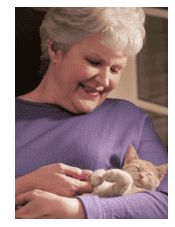Petsmart 2003 Annual Report Download - page 20
Download and view the complete annual report
Please find page 20 of the 2003 Petsmart annual report below. You can navigate through the pages in the report by either clicking on the pages listed below, or by using the keyword search tool below to find specific information within the annual report.82% since 1994. Based on the 2003/2004 APPMA National Pet Owners Survey, more than 64 million households in
the United States own a pet. This translates to approximately 78 million cats and 65 million dogs. The APPMA also
estimates 62% of United States households own a pet and 46% of those households own more than one type of pet.
The pet product industry can be divided into the following categories: food, supplies/medicines, vet care, pet
services (such as grooming or boarding), and live animal purchases. The APPMA estimates dog food, cat food, and
treats represent the largest volume categories of pet-related products and in 2003 approximated $13.0 billion or
more than 40% of the market. Many premium pet food brands, which oÅer higher levels of nutrition than non-
premium brands, are not currently sold through supermarkets, warehouse clubs, and mass merchandisers due to
manufacturers' restrictions, but are sold primarily through superstores, specialty pet stores, veterinarians, and farm
and feed stores.
Pet supplies and medicine sales account for approximately 25% or $7.6 billion of the market. These sales
consist of items such as dog and cat toys, collars and leashes, cages and habitats, books, vitamins and supplements,
shampoos, Öea and tick control, and aquatic supplies. Vet care, pet services, and animal purchases represent
approximately 22%, 8%, and 4%, respectively.
Competition
Based on total sales, we are the largest specialty retailer of pet food, supplies, and services in North America.
The pet food and pet supply retail industry is highly competitive and can be categorized into Ñve diÅerent segments:
‚ Supermarkets, warehouse clubs, and other mass merchandisers;
‚ Specialty pet supply chains and pet supply stores;
‚ Independent pet stores;
‚ Catalog retailers; and
‚ Internet retailers.
We believe the principal competitive factors inÖuencing our business are product selection and quality,
convenience of store locations, store environment, customer service, price, and availability of pet services. Many of
the products we oÅer are not currently available in grocery stores, warehouse clubs, or other mass merchandisers due
to manufacturers' restrictions. We believe we compete eÅectively within our various markets; however, some of our
mass merchandiser competitors are larger in terms of overall sales volume and have access to greater capital.
We are currently the only major specialty pet retailer that markets to customers through stores, catalogs, and
the internet, and we believe this gives us a competitive advantage. In addition, we believe our pet services business,
which grocery stores and mass merchandisers are not likely to duplicate, is a competitive advantage.
Our Strategy
Our strategy is to be the preferred provider for the lifetime needs of pets. Our primary initiatives include:
Add stores in existing multi-store and new single-store markets. Our expansion strategy includes increasing
our share in the top 60 existing multi-store markets, penetrating new single-store markets, and achieving operating
eÇciencies and economies of scale in distribution, procurement, marketing, and store operations. During 2003, we
opened 60 net new stores and we expect to open approximately 90 net new stores in 2004, primarily in multi-store
markets. Approximately 40% of those store openings are planned in markets in the Northeast and California where
we are signiÑcantly under-represented. We believe there is a potential for at least 1,200 PETsMART stores in North
America.
Provide the right store format to meet the needs of our customers. As of February 1, 2004, we had completed
the conversion of our store base to our new specialty store format. We believe our reformatted stores, combined with
our other strategic initiatives, contribute to higher comparable store sales growth, proÑtability, and return on
investment. We continually evaluate our store format to ensure we are meeting the needs and expectations of our
customers, while providing a return on investment to our shareholders. We are currently testing additions to this
reformat, including updated signage and other changes designed to attract new customers and promote lifetime
loyalty.
Expand our pet services business. Based on sales, we are the leading provider of professional grooming and pet
training services. Pet services are an integral part of our strategy, and we are focused on driving proÑtable growth in
2
























